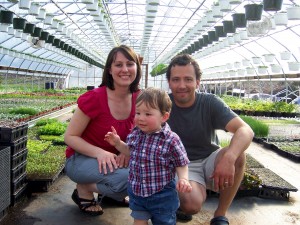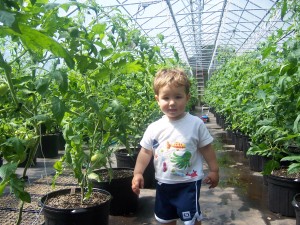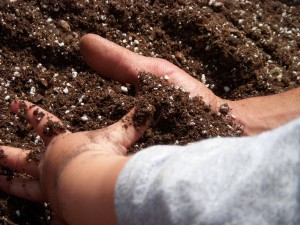Recently a reader asked us if we had a copy of this article, published in September of 2009. That particular issue isn’t online, but we are happy to post the story’s words and pictures, albeit without its stylish layout, here for all to read. Our writer Michelle Sutton was Michelle Buckstrup then, and many other things may also have changed…we’ll have to see what Todd says about that.
Todd Lighthouse Pioneers His Way into the Sustainable Mix
When Todd Lighthouse first worked for a greenhouse operation in 1999, he says he “disliked but also was intrigued by the fact that you are firmly tied to a piece of land.” But as he gained more experience with growing—working for small and large conventional operations, then charting his own course in sustainable growing—the intrigue won out. Now, Todd and his wife Andrea, a school psychologist, and their son Jack, 18 months, are happily rooted to their home and greenhouse in Honeoye Falls.
Todd and Andrea met as students at SUNY Potsdam. Todd double majored in biology and anthropology, with a particular interest in ethnobotany, the study of people and plants and how they evolve in relation to one another. Todd was perhaps most influenced by his professor of Plant Protection & the Environment, Ray Bowdish, and it was interning for Ray’s family wholesale greenhouse that gave him his start in growing.
After graduation in ’99, Todd worked for Dr. Joe Kovach at Cornell’s Geneva Experiment Station. Kovach was at that time one of the only organic guys in the IPM department,” says Todd. “He was doing some revolutionary stuff as far as plant protection.”
The bee mats is a great example. Kovach specialized in small fruit production and did trials in strawberry beds learning how to protect the plants in the most environmentally conscious way from pests like tarnish plant bugs, slugs, and botrytis rot. He grew several distinct plots: Those grown with conventional sprays, those grown with organic means, and those that got no treatment. Todd’s job was to scout for insects and record the damage to and yield of strawberries in each plot. Kovach was also big into honeybees.
Todd watched, fascinated, as Kovach tested out using a biological control, a fungus called Trichoderma harzianum to control botrytis rot on strawberries by putting the biological agent on mats at the bee hive entrance. As the bees left the hive and went to pollinate strawberry flowers, the bee legs would deposit the beneficial fungus right where it was needed, so the bees did all the work. (An article about this can be found at www.nysipm.cornell.edu/publications/beedissem.)
Todd worked for a summer at the Garden Factory, helping replace a variety of greenhouse structures and coverings that had been hit by a late spring storm. “I really learned greenhouse tech and construction through that experience,” he says. After spending a year in Colorado with Andrea, Todd returned to the Garden Factory and stayed for three and a half years, this time as a grower. “I really cut my teeth there in terms of growing,” he says. “They start nearly everything themselves, so I was able to see the whole growth history of all these different crops.” Todd was given the opportunity to test out biological pest controls there and use scouting techniques to reduce the amount of spray required. “They were really good about giving me the tools I needed,” he says.
Eventually, Todd wanted to do his own thing, so in 2006, he started Lighthouse Gardens, building a greenhouse in the back of his agricultural-district property right in Honeoye Falls.
***
What was your intention for your business starting out?
Todd Lighthouse: My first thought was that I didn’t know what I was going to grow but I knew I wanted to grow as organic as possible. I decided to start with ornamental plant starts, using organic methods. There’s no rulebook for this, unfortunately. I became friends with a lot of the certified organic farmers in the area—after going to farmers markets together, you become friends and speak the same language. I am trying to take their techniques of growing in the soil, farming the sun and getting as much as they can out of the sun in a given space while increasing, not depleting topsoil—and apply what they do to achieve that in a container somehow. In addition to my farmer friends, I’m very much influenced by Maine organic farmer, researcher and author Elliot Coleman (www.fourseasonfarm.com).
How do you grow differently than conventional greenhouse growers?
TL: Conventional growers pump plants with synthetic fertilizers that are readily available to the plant so they grow and grow—it’s like eating as much as you can but never getting full—then growers have to spray growth regulators on the plants to curb growth. I’ve always viewed that as two opposing forces butting heads. I’d rather give the plant what it needs and let it take up fertility as it needs it. There’s no need to spray growth regulators then. These plants stay compact on their own. The growth is a little bit slower, but it’s a robust growth rather than a lean flushing out of foliage.
Also, conventional greenhouse operations try to grow in closed systems, trying to exclude life. They have insect screens and an antibacterial footmat you have to walk across. I take the complete opposite approach by letting everything into the system. I believe trying to keep a system closed isn’t truly possible even in a greenhouse setting because you’re bringing in inputs from off the farm and can’t always trust that they’re clean. I’d rather just let everything in, and give the plant exactly what it needs so it can defend itself. I’m really just a steward of the whole system.
When I started in 2006, I thought organic greenhouse growing was just not spraying chemicals and using organic fertilizers so I used the organic potting mixes out there. So for instance whereas conventional soil mixes have synthetic wetting agents, petrochemicals to allow peat to take in moisture after it dries out, organic growers use yucca extract that performs the same function. Whereas conventional mixes have synthetic fertilizers, organic mixes rely on organic fertilizers like fish emulsion or manure solutions. Knowing how much to use was a real challenge. The conventional growers can measure their concentration of Nitrogen (N) using an EC meter to test the electrical conductivity of solution to determine parts per million of N. Organic growers don’t have such a precise means of measurement. So it was always a guess, and it was like I was mimicking the conventional approach, but with organic inputs, and my crops were decent, but not meeting my expectations.
How did you address this?
TL: I came across atomized rock powders (greensand, rock phosphate) and liquid bonemeal and bloodmeal that could flow through an injector sprayer for foliar application, which feeds the plant more quickly. But I didn’t see a real improvement over the previous year.
I kept reading and researching and played around with this organic medium called Vermont Compost. My friend Brian Beh, the only other organic grower of vegetable and herb starts in the area, uses Vermont Compost as his potting mix. But Vermont Compost is expensive (justifiably so, it’s a great organic product), and for such things as hanging baskets and large pots of ornamentals, using it would be prohibitive for me. Also, I think of soil and soil fertility as a valuable natural resource that should be kept as local as possible. I thought I’d try making my own mix, starting with compost. The compost provides structure and water retention but I don’t use it as a source of fertility; it’s the medium that provides microbial life to the mix that makes possible the chemical reactions that allow fertility to be released from the other components and made available to the plant’s roots.
I used Elliot Coleman’s design of a straw bale composting system with a series of bays from which compost is turned. The straw bales train heat so the edges of the compost pile stay warm and the components break down faster. I even sourced organic straw bales. I built the bays but for me, the labor was so intense and I couldn’t get enough compost ready when I needed it.
I found a local compost maker, Mark Wittig in Trumansburg of Cayuga Compost. He takes scraps from the Moosewood Restaurant and makes gorgeous compost. I now use Cayuga Compost and peat to make a half dozen of my own mixes, which vary in composition depending on what size container and what plant I’m growing. I start with the high quality Cayuga Compost and get what’s called blond peat, which is much longer-fibered than the peat you see at garden centers, and because of that added fibrousness adds more structure to the mix. To the compost and peat I add the rock powders, bloodmeal, and bone meal. Then I add vermiculite and perlite for added porosity and air flow, more for hanging baskets and larger pots, less for smaller containers. Lastly, a little bit of kelp in powder form for phosphorous and micronutrients and a little bit of lime to compensate for the lower pH of peat.
This mix, in my experience thus far, provides the plants everything they need. My customers and I have really noticed the difference in the way the plants look and behave. It’s like the plants are expressing themselves as they truly are. They’re full and robust and dark green and compact. Before using this mix I had more trouble with aphids and would have to bring in beneficial insects and organic treatments like Neem oil spray. But now the few aphids I’ve seen have been so localized. My theory is that the plants can better defend themselves but also it may have to do with there being less synthetic nitrogen, which produces a kind of growth that aphids love. Now, all this said, next year might be a different story, but so far, the plant response to my growing mix have been very positive.
Will you sell this mix to other farmers or to customers?
TL: This year I sold small quantities on an as-needed basis to customers, but my farmer friends are starting to express interest. I’d have to invest in better equipment before I could expand the sale of it. Right now I use a 2 cubic foot cement mixer to make one small batch at a time. The time it took me to make what I needed this year—20 yards—was kind of insane, so I have to get better mixing equipment.
Why is your mix better for the environment?
TL: The thing about compost and rock powders is that they are temperature released, not time released. As the sun warms the compost in the potting mix, there is an increase in activity in the mix, which increases the uptake of fertility by the plant as the plant needs it. What it doesn’t need, stays put. With synthetic fertilizers, any that isn’t used by the plant right away is washed out and ends up in the groundwater. Now that I’m growing the way I do, I’m realizing that organic growing isn’t so much about pesticides, it’s about the fertilizers. The phosphorous from synthetic fertilizer that leaches into our watershed is a huge problem now.
You started out with multipacks of perennials but seem to be moving toward doing fewer ornamentals, more herbs and veggies. And I see that this summer, your greenhouse is filled with tomato plants!
TL: The customers that are buying the herbs and vegetable starter plants really want them grown organically. About the perennials they’ll say, “Why should I buy organic perennials? I’m not going to eat them.” My response is you do drink the water and breathe the air that is polluted by conventional growers. Also, conventionally grown plants have pesticide residues on them and you’re touching those plants. If I were growing using conventional means, I would not let my son in the greenhouse. I would not wear sandals in here. That said, in the reality of the marketplace it’s looking like the demand from my customers is much greater in the realm of herbs and veggies, so I am shifting my plant mix in that direction.
The tomato project you see here is inspired by my friend Brian Beh of Raindance Harvest Farm—he’s the one who really encouraged me to take all my leftover tomato starts and grow them in pots. I was reluctant at first because I didn’t feel right about not growing tomatoes in soil. With tomatoes grown hydroponically, for instance, there’s no flavor and little nutrition. You put that hydroponic tomato next to a soil-grown tomato and there’s no comparison in the taste. But this year I’m using my refined potting mix, and I thought if I’m having stellar success with other plants, I should see what happens with the tomatoes. I’ve got 350 plants in 5-gallon containers, the smallest container one can really get away with using for tomato growing. Most are heirloom varieties. I’ve trained them to a truss system whereby tomato twine is hung from hanging basket lines and lowered to the plant, which grabs hold and grows up. The 350 plants pretty much fill my greenhouse, and as of mid August, their foliage has remained dark and beautiful and no supplemental fertility has been needed.
What has been your role in promoting Rochester-area farmers markets?
TL: With my farming colleagues I am a founding member of the South Wedge Market (Thursday evenings) that began two years ago, and I helped found the Brighton Market (Sunday mornings) last year. Both feature local producers only. At South Wedge some of us growers collectively provide a subscription service to customers who want weekly deliveries of what’s in season.
I also sell at the Rochester Public Market. There’s a lot of haggling that goes on, but sales can be brisk because there’s so much foot traffic. Also, I enjoy it from my anthropologist’s point of view—where else in Rochester can you see people of so many different socioeconomic and cultural backgrounds in one place? However I do find the South Wedge and Brighton markets more gratifying because there’s time to get feedback from my customers there and because the value of my product is appreciated.
Fred Forsburg, proprietor of Honey Hill Organic Farm in Livonia, on his fellow grower Todd Lighthouse
“For Todd, quality is his first and most important concern. Being that I’m a certified organic farm, I have to have organic transplants. We’ve been very pleased with Todd’s tomato and leek starts. The fact that he grows first-quality transplants using organic methods is extraordinarily rare in the greenhouse business. And with his own mix that he has developed, I think he’s a pioneer in our region.”
Brian Beh, proprietor of Raindance Harvest Farm in Ontario
“Todd and I got to know each other as two young guys in the business, which are kind of rare as sustainable farmers go. We started talking business and became good friends. Now our families socialize, and we go to concerts together, but Todd and I have a hard time not talking nonstop about compost. We are soil nuts. A lot of people make compromises in their business, but Todd doesn’t. His integrity and ethics are the highest you could imagine.”
Todd is hoping to get his operation certified organic in 2010 through NOFA-NY (Northeast Organic Farming Association). For more information about Lighthouse Gardens, see Lighthouse-gardens.com
Honeyhill Organic Farm: www.honeyhillorganicfarm.com
South Wedge Farmer’s Market, Rochester: www.swfarmersmarket.org
Raindance Harvest Sustainable Farms: raindanceharvest.com
Brighton Farmer’s Market: www.brightonfarmersmarket.org
A great source on all things sustainable in growing:
ATTRA www.attra.org
Michelle Buckstrup is a horticulturist in Rochester, New York.
Update as of 1/4/15: Todd just posted this to our facebook page—Wow Jane! It’s been a while since I’ve read that. Thanks for posting it! We’ve grown so much in the past 5 years. I did purchase that mixing machine and became certified organic. We’ve branded our organic potting soil as “The Living Earth Organic Potting Soil” which has now become about half of our business. We supply many farmers, both conventional and organic in the area including the Wegmans Organic Farm in Canandaigua. While we still vend at local farmers markets, wholesaling our organic herb and vegetable transplants represents the bulk of our sales. This spring we are looking forward to opening our new greenhouse and farm operation on route 15a in Lima with regular business hours so our customers can have access to every variety we grow rather that just what we are capable of bringing to market. We also continue our growing operation through the summer and fall with over 100 varieties of organic produce. I should also add that our son Jack is now a 1st grader and we’ve since had a daugher, Kate who is now 3!
Views: 12







